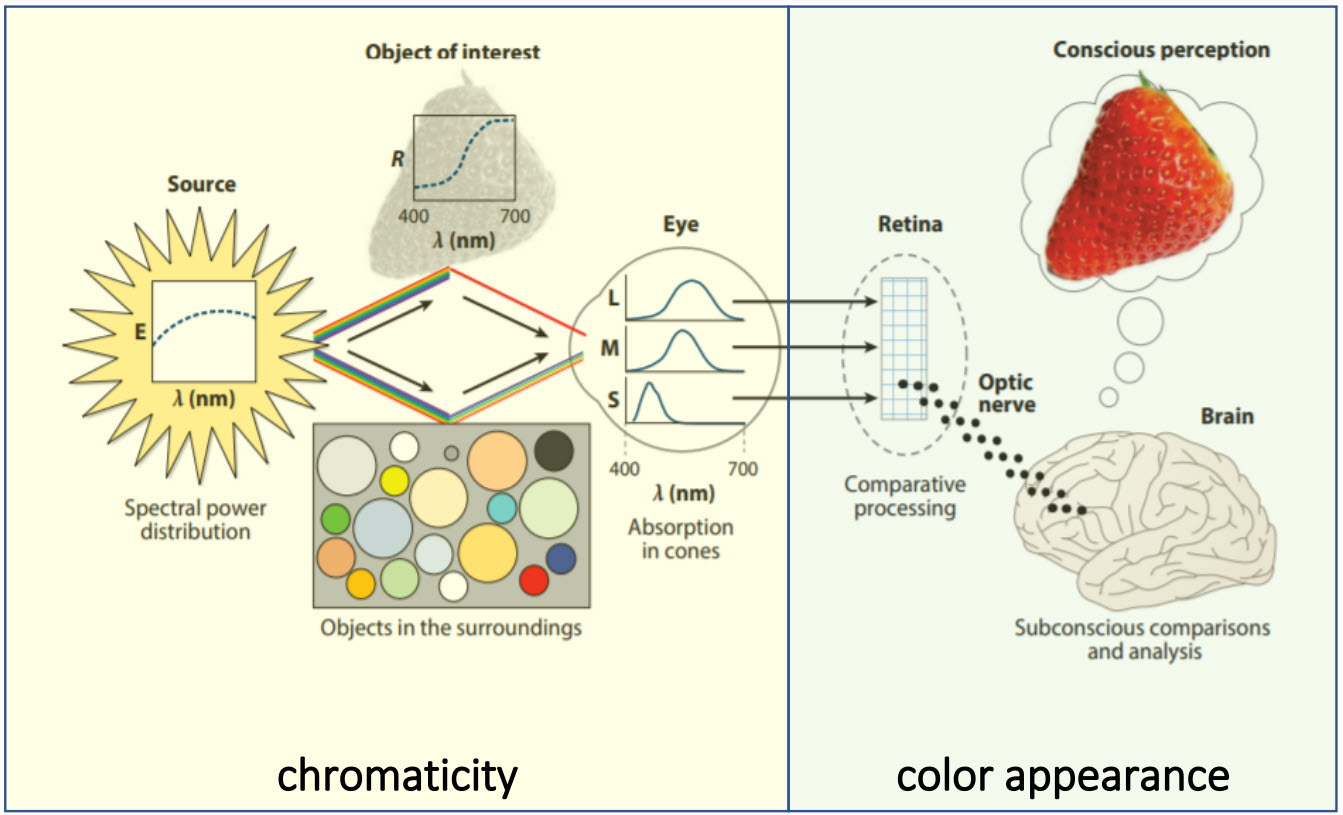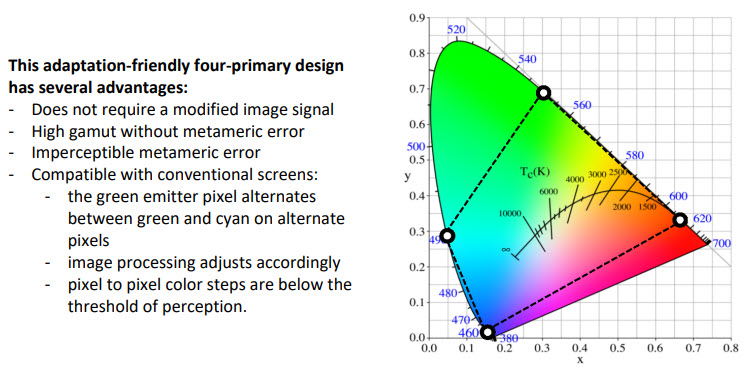Last week, Barry wrote about the developments in wide colour gamut displays and the trend to move to narrow primaries to enable the showing of as much as possible of the Rec. 2020 gamut. (Getting to BT 2020 — OLEDs vs. LCDs) That’s a good thing. Or is it?

Although like everybody in the technology industry, I know that ‘bigger must be better’, there is a relatively little discussed aspect of colour perception and that is metamerism – the phenomenon that means that two colours that measure as having the same colour coordinates can look different if the spectral power distribution of the light is different.
I first came across this issue when LCD monitors started to move to LED backlighting. Because the spectral power distribution of the LED backlights was very different from the CCFL backlights previously used (which were very broad), the same colour on two calibrated displays and measured displays could look different and that presented a challenge. Some companies in the market actually carried on making CCFL-based monitors for quite a long time after they might have changed because clients that cared about accurate colour had significant inventories of installed CCFL monitors and wanted to retain consistency among all their displays.
I’ve yet to meet anybody in the creative or industry side that doesn’t want to see wider colour gamuts, but usually the challenge in making WCG displays is leakage of one colour into another, so the really pure primaries cannot be achieved, limiting the colour gamut coverage. If you can separate the colours better, there is less leakage, and one way to do this is to have narrower FWHM for the different primaries – the kind of light emitted by quantum dots, for example.
This is not a new topic and the late and missed Matt Brennesholtz wrote an article back in 2014 that highlighted the topic. (Display Measurement in the Post-Phosphor Era) and included this comment:
“The speakers repeated horror stories where the Director, the Director of Photography and the Colorist all have different eyes and practically get in fist fights whether two side-by-side displays have the same white point or not. “
So, I was pleased to see a paper on this topic at the recent SID Display Week symposium by Prof. Lorne A Whitehead of the University of British Columbia. He started by explaining how colour perception works. Up to the light reaching the cones in the back of the retina is a question of maths and physics. The data about the image is passed to the brain and from that comes the perception of colour. So, in the diagram below, we are in the realm of physics on the left, but in the realm of psychology on the right (although experiences can be quantified in colour appearance modelling (CAM)).
He discussed an example of a calculation that showed a CAM formula used to determine chromaticity. It gives the result that viewers with abnormalities in their retinal response function nevertheless see most colours similarly to other viewers. There appear to be matching adaptive systems in the colour processing system that make things still work properly even if the cones are not average. So if a particular viewer has abnormalities in their retina, that does not mean that they will perceive colours differently. This adaptation has taken place in a world that was basically illuminated by broadband light (sunlight).
There are people that have significantly less separation between the red and green peaks of their colour vision than the standard or average viewer. Despite this, they can see colours quite normally because of the adaptation in broadband light. However, what happens if the light source is not broadband, but narrower?
Unfortunately switching to narrow three band illumination ‘wrecks things’ in Prof Whitehead’s words. What happens is that the adaptive systems no longer correct for the abnormalities. You can design a system with three narrow primaries to give accurate colours for those with normal red green perception, but that will cause problems for those that need the adaptation.
“This is the reason it is not appropriate to be using three narrow band primaries for displays for human beings. We shouldn’t be disadvantaging people that have perfectly good colour vision simply because they aren’t average”.
The problem can be reduced somewhat by changing the peak wavelengths of the primaries to make them different and he showed calculations that highlighted that there is still some error (0.65 Munsell units) which is still perceptible, but not significantly worse for abnormal viewers than for the average viewer. However, moving the primaries means a very low gamut, and everybody wants wider colour gamuts, so it’s not really a solution.
However, if you go to four primaries, there is a good solution all around and brings the error down to 0.3 Munsell units and 0.15 for those with average vision and is basically ‘not noticeable’. The advantages include:
-
It does not need a modified RGB signal
-
The gamut is high (but not incredibly high)
-
Imperceptible metameric error
-
Compatible with conventional geometries.
-
Not all pixels have to have all 4 primaries to get a good result. If you use alternating green and cyan pixels, however, you can get a good image as the differences from pixel to pixel are not perceptible
So, by switching to this kind of architecture of RGBC, the industry could solve the issue of metamerism, with a high colour gamut, although, of course, it would not be Rec. 2020. Rec 2020 did not seem to have been based on any real user testing or human factors other than giving coverage of Pointer’s colours (the colours we see in the real world). One participant in the committee told me several years ago, that ‘We looked at where the engineers were and just pushed things out a bit’ (or words to that effect).
Prof. Whitehead did point out that you could go for an even wider colour gamut if you went to five primaries, but that might start to be more complicated and I remember the discussions with Genoa, the Israeli company that was promoting multi-primary solutions some years ago, and was eventually bought by Samsung, about the difficulty of getting multi-primary solutions adopted. The main one that I remember being adopted was the Sharp RGBY scheme Quattron) introduced around 2010, but that was abandoned, I think.
Anyway, an understanding of the key reason behind the metamerism issue that Matt talked about should be useful for future developments. (BR)




